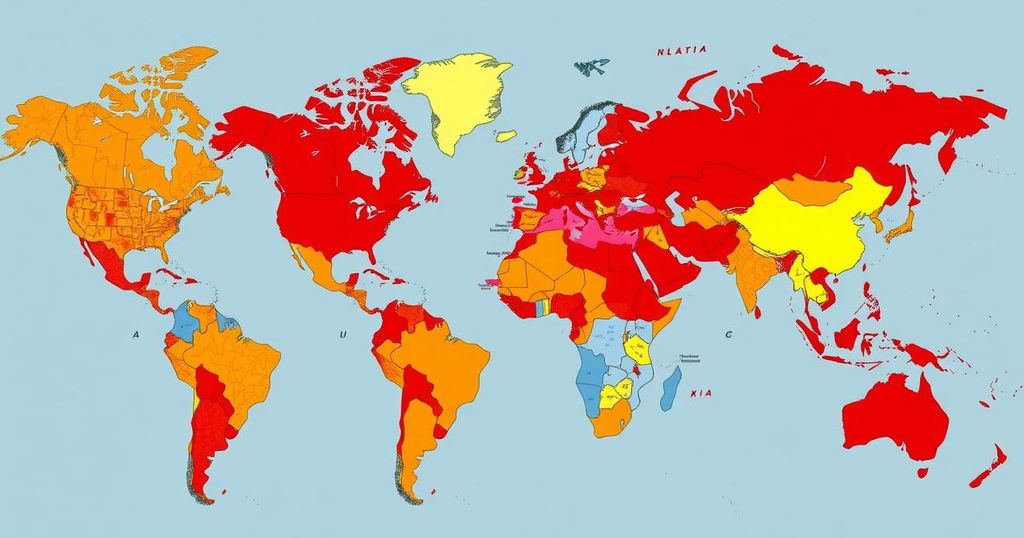World news
ASIA, AUSTRALIA, BRAZIL, CANADA, COLOMBIA, CUBA, DISPLACEMENT, EL SALVADOR, EMERGENCY RESPONSE, EUROPE, GERMANY, GUATEMALA, INDIA, INTER - AMERICAN DEVELOPMENT BANK, LATIN AMERICA, LATIN AMERICAN, MEXICO, NATURAL DISASTER, NATURAL DISASTERS, NORTH AMERICA, OCEANIA, PHILIPPINES, SOUTH AMERICA, SPAIN, U. S, UNITED KINGDOM, UNITED STATES, VENEZUELA
Lena Nguyen
0 Comments
Global Gun Violence: A Disparity Among Countries
Gun violence results in over 250,000 deaths annually, heavily influenced by geographical factors. A majority of fatalities occur in Brazil, the U.S., and Mexico, while countries with stringent gun control, such as Japan and Australia, report significantly lower rates. Key factors include organized crime in Latin America and high suicide rates in the U.S.
Gun violence results in hundreds of thousands of fatalities worldwide annually, with the risk of being shot varying significantly based on geographical location. In 2019, firearm-related deaths reached over 250,000 globally, predominantly homicides (71%), followed by suicides (21%), and unintended firearm incidents (8%). Uncommon but notable are gun deaths arising from mass shootings, which receive significant media attention.
A staggering 65.9% of the world’s gun-related fatalities in 2019, which totaled approximately 250,227, were concentrated in only six nations: Brazil, the United States, Venezuela, Mexico, India, and Colombia. Brazil led the statistics with 49,436 fatalities due to firearms, closely followed by the United States at over 40,000 deaths, and Mexico in third place with more than 30,000 gun-related fatalities.
The United States ranked 20th for gun fatality rates in 2016 and saw a drop to 28th in 2021, reporting 4.31 deaths per 100,000 individuals—over seven times that of Canada’s rate of 0.57 and 340 times that of the United Kingdom’s rate of 0.013. A 2018 analysis indicated that the U.S. gun death rate stood at 10.6 per 100,000, which is significantly higher than various countries including Canada (2.1) and Australia (1.0), but lower than El Salvador (39.2), Venezuela (38.7), and Guatemala (32.3).
Latin America faces unprecedented levels of gun violence, primarily attributed to organized crime and drug trafficking. A report by the Inter-American Development Bank points to numerous factors underlying this violence, including economic hardship, housing instability, family disruptions, school dropout rates, demographic trends, and alcohol misuse. While gang violence is a major contributor in this region, the U.S. gun deaths predominantly stem from suicides, accounting for 63% of fatalities in 2019, contrary to common belief focusing on mass shootings.
In stark contrast to the U.S. and Latin American countries, nations like Japan, the United Kingdom, Norway, and Australia experience very low gun death rates, thanks to their stringent gun control laws. For instance, Australia commenced a permanent gun amnesty program in 2021, encouraging public surrender of unregistered firearms. Japan’s effective gun control measures have resulted in a mere gun death rate of 0.02 per 100,000 people in 2019. To obtain a firearm in Japan, citizens must complete a full-day class, pass a written test, and achieve a minimum accuracy of 95% in a shooting assessment.
Gun violence remains a critical global issue, with particular countries exhibiting disproportionately high firearm death rates. Brazil, the United States, and Mexico show alarming fatality figures due to various factors, including organized crime and suicide rates. Conversely, stringent gun control measures in countries such as Japan and Australia contribute to significantly lower gun death rates. Addressing the underlying causes of gun violence remains essential for reducing fatalities in affected regions.
Original Source: globalsouthworld.com




Post Comment